 Dr. Robert MacGregor, CDA president (far left), and Dave Hancin, vice-president and general manager, DENTSPLY Canada (far right), with the participants of the 2011 CDA/DENTSPLY Student Clinician Research Program.
Dr. Robert MacGregor, CDA president (far left), and Dave Hancin, vice-president and general manager, DENTSPLY Canada (far right), with the participants of the 2011 CDA/DENTSPLY Student Clinician Research Program.
The 2011 CDA/DENTSPLY Student Clinician Research Program took place in Halifax in August during the CDA Annual Convention. This national clinical research competition invites dental students from the 10 accredited Canadian dental schools to present research table clinics in front of qualified judges.
Simon Jean of the University of Montreal was judged the winner of the 2011 program for his research exploring the mechanisms involved in the induction and maintenance of orofacial chronic muscle pain. His first prize is an expense-paid trip to the upcoming American Dental Association (ADA) annual meeting in Las Vegas, Nevada, in October, where he will present his research during the ADA’s scientific program.
“Participating in this program was an enriching experience because it gave me the opportunity to share my findings with others, which I consider a main part of scientific research,” he says. “Talking with other students that share my interests was great because I realized that I wasn’t the only one who thinks that research is the key to the improvement of clinical practice,” he adds.
The runner-up in this year’s competition was Erin McDonald of the University of Western Ontario. Her research examined whether histatin 1 maintains its intact form in the proteolytic environment of oral fluids. “It was really inspiring to see the diverse range of research being performed across the country and how passionate my fellow students were about their projects,” she notes. Ms. McDonald receives a $1000 cash award from DENSTPLY for her second-place finish.
DENTSPLY has sponsored the Student Clinician Research Program for more than 40 years. The program’s purpose is “to stimulate ideas, to improve communication and most of all, to increase student involvement in the advancement of the dental profession.”
The student clinicians participating in the event are also honoured by the Canadian section of the Pierre Fauchard Academy (PFA). The students are presented with a scholarship from the PFA recognizing their special efforts in the advancement of dental education over and above their academic careers.
Dr. Euan Swan, CDA manager of dental programs, and Dr. Bernard Dolansky, former president of CDA, were the official judges at the Halifax event.
++++++
JCDA is pleased to publish condensed versions of the abstracts submitted for the CDA/DENTSPLY 2011 Student Clinician Research Program. To qualify, the study must fall under the “clinical application and techniques” or “basic science and research” categories. Students must identify the purpose of the study, provide background information, outline how the study was conducted and report on the results of the study and its possible significance. The student, selected by his or her own faculty, must be an undergraduate at the time of the presentation, as well as a member of CDA. All 10 dental schools participated in this year’s competition.
The abstracts are published in the language of submission.
1st Place
Mechanisms involved in induction and maintenance of orofacial chronic muscle pain
By Simon Jean, University of Montreal
Advisor: Dr. Pierre Blanchet
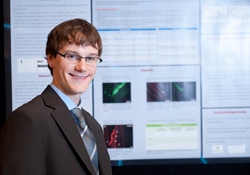 Simon Jean
Simon Jean
Pain sensation normally involves activation of small-calibre primary afferents, known as nociceptors. Several pain syndromes result from the dysfunction of these afferents. However, other pain syndromes have shown increases in excitability of large-calibre primary afferents, whose activation is normally associated with perception of non-noxious mechanical stimuli. This leads to the hypothesis that an increased activity in large fibres may activate nociceptors through peripheral interactions.
We tested this hypothesis by 1) investigating the physical proximity of small-calibre fibres identified with nociceptive markers and large-calibre fibres labelled with VGlut1, the glutamate transporter found in nerves that release this neurotransmitter; 2) verifying if the putative nociceptors had glutamate receptors; 3) examining the presence of ionic channels (CaV3.2, HCN2, and NaV1.7) on peripheral endings of muscle spindle afferents (MSA) that could explain their increased excitability.
Immunohistochemical experiments were performed on male Sprague Dawley rats. The primary antibodies tested were CGRP, mGluR5, P2X3, PGP 9.5, TRPV1, VGLUT1, CaV3.2, HCN2 and NaV1.7.
Putative nociceptors were found in close proximity with large-calibre fibre endings that can release glutamate in muscle spindles. The data suggest that glutamate released from MSA could contribute to the recruitment of nociceptive pathways by a peripheral interaction into the muscle, which could lead to the establishment of chronic muscle pain. Experiments described the distribution of some ionic channels that could represent new targets for the development of therapeutics for the treatment of orofacial chronic muscle pain.
2nd Place
Histatin 1 resists oral proteolytic environment when adsorbed to hydroxyapatite
By Erin McDonald, University of Western Ontario
Advisor: Dr. Walter Siqueira
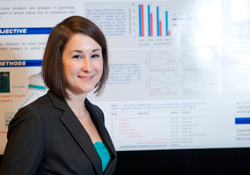 Erin McDonald
Erin McDonald
The acquired enamel pellicle (AEP) is a layer formed on enamel surfaces by the selective absorption of salivary proteins. The AEP functions as a lubricant and a selective barrier regulating demineralization, and also controls the composition of the microbial flora in contact with enamel surfaces. Histatins belong to a group of antimicrobial salivary proteins that have high affinity for hydroxyapatite (HA) and are thought to initiate pellicle formation. Although intact histatin is present in glandular secretions, it is virtually absent in whole saliva (WS) due to extensive proteolytic degradation in the oral cavity.
The aim of this study was to assess whether histatin 1 could maintain its intact form in the highly proteolytic environment of oral fluids when adsorbed on enamel surface.
Histatin 1 was pre-incubated with synthetic HA crystals for 120 min. At equilibrium, the histatin l/HA complexes were incubated in WS supernatant at 37°C for various time intervals. The bound histatin 1 was recovered after dissolution of crystals and analyzed by cationic gel electrophoresis, HPLC and MALDI-TOF.
Incubation of intact histatin 1 in WS resulted in a loss of approximately 30% at 30 min and 75% by 120 min. In contrast, incubation of WS with histatin l/HA complex caused minimal degradation (14%) over the 120 min incubation period.
The present study shows, for the first time, that binding to HA confers resistance to proteolytic degradation of intact histatin 1. These findings open new avenues for the development of studies that can provide insight on the early treatment of oral diseases, such as dental caries.
Erbium lasers: toys or tools for restorative dentistry?
By: Natasha Chishti, Dalhousie University
Advisor: Dr. Mark Knechtel
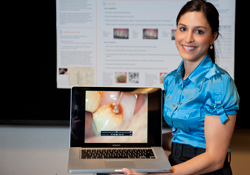 Natasha Chishti
Natasha Chishti
Modern dentistry has adopted a minimally invasive approach to caries management. Yet when cavitation occurs, a surgical approach is needed to remove the infection. At present, the high-speed handpiece is the instrument of choice for effective caries removal. This procedure has some disadvantages, such as an irritating noise, uncomfortable vibrations, stress and pain for patients and the unnecessary removal of sound tooth structure.
To overcome these disadvantages, new technologies for dental hard tissue removal, such as erbium lasers, have been developed. Since receiving FDA approval in 1997, erbium lasers have reportedly been used to successfully remove caries in all classes of cavity preparations without local anesthesia. Patients have expressed a preference for future restorative treatment with lasers instead of conventional handpieces.
The purpose of this literature review was to determine whether the marketing claims for erbium laser use in restorative dentistry are founded on solid scientific evidence and if erbium lasers confer additional benefits for patients and practitioners compared to current dental technology.
We searched the PubMed database and the Cochrane Library. Journal articles were selected based on a hierarchy of evidence, with systematic reviews of randomized clinical trials considered the highest quality evidence and case reports the lowest.
Currently there is a lack of high-quality evidence to substantiate the marketed uses of erbium lasers in restorative dentistry. The safety, efficacy and benefit of erbium laser use in restorative dentistry is questionable until manufacturer claims are supported by independent, reproducible studies published in peer-reviewed journals.
Screening for novel inhibitors of cathepsin K
By: Michael Ho, University of British Columbia
Advisor: Dr. Ravindra Shah
 Michael Ho
Michael Ho
Cathepsin K (catK) has recently received considerable attention because of its major contribution to the digestion of extracellular matrix in bone remodeling, particularly in the breakdown of the collagen network. In fact, overexpression of catK is found in diseases such as arthritis, osteoporosis and invasive breast cancer. Therefore, it is important to screen for potential inhibitors of catK.
Potential inhibitors were tested in vitro by using the collagen and gelatin assay. These 2 assays will not only determine if the molecule can inhibit catK but will help determine whether the molecule will inhibit by interfering with the active site or the formation of the catK/C4-s complex.
A couple of molecules that we screened showed positive results in inhibiting catK by potentially disrupting the catK/C4-s complex. We believe this complex is required in the degradation of type 1 collagen as our lab has shown that C4-s enhances the degradation of collagen by catK.
Association between BMI and severe early childhood caries
By Katherine Davidson, University of Manitoba
Advisor: Dr. R.J. Schroth
 Katherine Davidson
Katherine Davidson
Severe early childhood caries (S-ECC) is an aggressive subtype of early childhood caries affecting children < 72 months of age. These children tend to have a reduced quality of life and altered growth patterns. The objective of this study was to compare body mass index (BMI) between children with S-ECC and those who are caries-free.
Between October 2009 and June 2011, children ≤ 72 months with S-ECC requiring general anesthesia were recruited from Winnipeg on the day of their dental surgery. Age-matched, caries-free controls were recruited from the community. Children were participating in a larger study on nutrition and S-ECC. Only children ≥ 24 months were included in this substudy. Parents completed a questionnaire and the height and weight of the children were recorded. BMI scores and age- and gender-adjusted BMI percentiles were calculated according to the Centre for Disease Control guidelines. A p value ≤ 0.05 was significant.
Over 250 children took part in the larger study; 232 were ≥ 24 months and therefore included in the BMI analysis (141 children with S-ECC and 91 caries-free children). The mean age was 43.2 ± 12.9 months and 51% were males. About one-third (34.4%) of participants were either overweight or obese, more than double the proportion expected.
Of the children categorized as obese, 75% had S-ECC. Height or weight did not significantly differ between the groups. Children with S-ECC were significantly more overweight when comparing the age- and gender-adjusted BMI percentiles (69.0 ± 29.2 vs. 57.2 ± 31.6, p = 0.005). Therefore, an association between severe caries and obesity may be plausible.
An in-vitro study of the efficacy of moisture-tolerant resin-bonded sealants
By: Eric Knouse and Jill Kulyk, University of Saskatchewan
Advisor: Dr. Carol Nagle
 Eric Knouse and Jill Kulyk
Eric Knouse and Jill Kulyk
Traditional pit and fissure sealants have been shown to be highly effective at preventing caries. However, success can be difficult due to saliva contamination during placement. Recently, a moisture-tolerant sealant has been developed that could overcome this problem.
An in vitro comparison of traditional sealant material and moisture-tolerant sealant material was performed in both a dry and moist environment. Eighty (80) non-carious third molars and bicuspids were divided into 4 groups: those treated with traditional sealant (Ultradent XT) or moisture tolerant sealant (Pulpdent Embrace Wetbond) each in dry and moist environments. Sealants were applied following manufacturer specifications and samples were thermocycled for 2000 cycles in artificial saliva. The samples were stained using 2% methylene blue and sectioned using a slow-speed diamond saw. They were examined under stereoscopic microscope for depth of penetration of the dye under the sealant. Dye penetration was assessed on a 4-point grading system. The statistics were compiled with SPSS 17.0 and STADA for chi-square test looking for descriptive analysis for dissociation. Pearson chi-square test of combined pools of no penetration depth versus penetration was applied.
The traditional sealant placed in a dry environment was significantly more effective than the moisture-tolerant sealant placed in a moist environment. The moisture-tolerant sealant performed similarly in both dry and moist environments. The moisture-tolerant sealant both moist and dry performed much better than the traditional sealant in the moist environment. These results indicate that the traditional sealant is superior as long as a dry, isolated environment is achievable.
Assessing the change in dental students’ attitudes toward the care of high-risk, underprivileged populations in a dental school community program
By: Layal Ksaybi and Jennifer Seidler, McGill University
Advisor: Dr. Veronique Benhamou
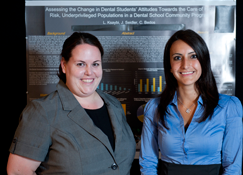 Jennifer Seidler and Layal Ksaybi
Jennifer Seidler and Layal Ksaybi
Racial and ethnic oral health disparities are a common, multifactorial problem in the Montreal region. This study described dental students’ perceptions and levels of comfort and concern with treating high-risk, underprivileged patients in a university dental outreach community program throughout the 4 academic years of the DMD program. It further investigated students’ future willingness to treat similar patients.
Eighty six (86) dental students from a university dental program were given a survey in which students rated responses using a 4-point scale with the objective of understanding the effectiveness of having an outreach program as a mandatory component of the DMD curriculum. It also looked at the effect it had on their attitudes toward treating high-risk population groups, and willingness to treat such patients in their future practices. Data were analyzed using the statistical SPSS 11.5 for Windows software.
It can be concluded that the level of training, including didactic knowledge, technical skills and clinical experience, may improve a student’s level of comfort when treating high-risk, underprivileged patients encountered in a dental outreach program. Students enjoyed participating in the program, despite their concerns over a higher risk of disease transmission. Female students were found to be more interested in treating an outreach population in their future practice. Within the limitations of this study, it can be suggested that implementing a dental outreach community program in the university dental curriculum has a significant effect on student perception of the outreach patient population and their level of involvement in the community.
Development of antimicrobial monomer systems
By Mike Laschuk, University of Toronto
Advisor: Dr. Boris Hinz
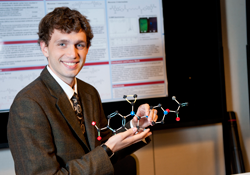 Mike Laschuk
Mike Laschuk
Antimicrobial agents used in restorative materials are primarily limited to fluoride in glass ionomer cements (GICs) or resin-modified GICs. A common challenge is controlling the diffusion of fluoride from GICs, which typically depletes their release early in the implant life. The objective was to synthesize 2 monomers with incorporated antibiotics, such as ciprofloxacin (CF), to use in the resin component of restorative composites. Such systems could provide long-term, controlled release of antibiotic activity.
CF was reacted with triphenyl chloride using triethylamine as a catalyst. Methanol was subsequently added to deprotect the carboxylic acid group. (N)-trityl ciprofloxacin was then reacted with triethylene glycol (TEG), using 4-dimethylaminopyridine (DMAP) and 1-ethyl-3-[3-dimethylaminopropyl] carbodiimide hydrochloride (EDC) as catalysts. The next phase involved deprotecting the amines, using trifluoroacetic acid and water, and the reaction of methacrylic acid with the terminal amines of the CF-component using EDC and DMAP as catalysts. The second monomer was synthesized by reacting CF with hexane-1,6-diisocyanate (HDI) in 4-dimethylsulfoxide at 60oC. In ongoing work, this product will be reacted with hydroxyethyl-methacrylate to yield the final monomer.
1H-NMR, 19F-NMR, time of flight mass spectroscopy, and thin layer chromatography were used to characterize the monomers at each step. N-protection of CF was successful, followed by coupling with TEG. The coupled product was deprotected, resulting in precipitate formation. CF-coupled HDI was also achieved and purified. The synthesis of antimicrobial monomers was achieved, and purification method development is in progress. Further work will investigate their use in coupling methacrylate agents for use in resin development.
Immigrant parents’ awareness of their child’s dental health status
By: Jenny (Eun Jung) Shim, University of Alberta
Advisor: Dr. Maryam Amin
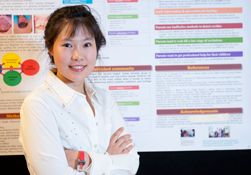 Jenny (Eun Jung) Shim
Jenny (Eun Jung) Shim
The aim of this study was to explore the level of awareness of a group of Punjabi-speaking and African parents about their children’s dental health and the factors that may influence their awareness.
Participants were parents and their 3- to 6-year-old children from Punjabi-speaking and 3 African communities who had lived in Canada for 10 years or less. Parents were asked to assess their child’s dental health and identify the indicators and ways they use to recognize dental caries. A dental exam was performed for children in a community location. Parental awareness was determined by comparing children’s normative status (clinically measured dental health status) with parents’ perceived status.
In total, 98 parents and 106 children completed the study. The mean defs were 5.8 (± 13.7) for Punjabi-speaking and 8.9 (± 11.4) for African-origin children. More than half of the children had never visited a dental office before. Almost three-quarters (73.4%) of Punjabi-speaking and 76.3% of African parents were unaware of their child’s dental health including parents who did not know their child’s condition at all. About 40% of parents referred to parental checking to assess their child’s dental health. Parents employed limited indicators for caries detection which often referred to an advance form of this disease. Parental perception of their child’s dental health did not seem to be a reliable proxy of actual status. Dental visits for preventive reasons should be promoted. Also, parents should be educated regarding indicators and effective ways of detecting caries.
Résorption osseuse suite à l’extraction d’une dent : mise en place d’un implant immédiat ou retardé
By: Sandrine Gosselin, Laval University
Advisor: Dr. Serge Roy
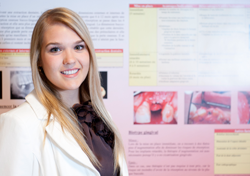 Sandrine Gosselin
Sandrine Gosselin
Le domaine de l’implantologie est en pleine effervescence. L’alternative des implants est de plus en plus envisagée dans le but d’avoir un résultat combinant esthétique et fonction. Par contre, les dentistes sont peu informés sur la perte osseuse associée aux différentes méthodes d’implantologie. Effectivement, les différentes techniques de mise en place d’implants, soit implantation immédiate ou retardée, possèdent des avantages et des inconvénients qui peuvent influencer le pronostic du traitement. Les traits physiologiques individuels, tels que le biotype gingival et la dimension verticale de la crête osseuse, ainsi que les contraintes survenues lors de l’extraction, telle une fracture de la crête, sont également des facteurs importants à considérer quant au choix de la pose d’implants.
Nous avons procédé à une revue de littérature. La littérature rapporte que 50 % de perte osseuse survient suite à une extraction dentaire. Le but de notre entretien clinique sera donc d’éclairer les dentistes sur les différentes lignes de conduite qui portent à minimiser cette perte osseuse. Ces indications pourraient-elles permettre, un jour, d’établir une procédure décisionnelle à appliquer quant à la mise en place d’un implant?
Photos courtesy of Teckles Photo Inc.
